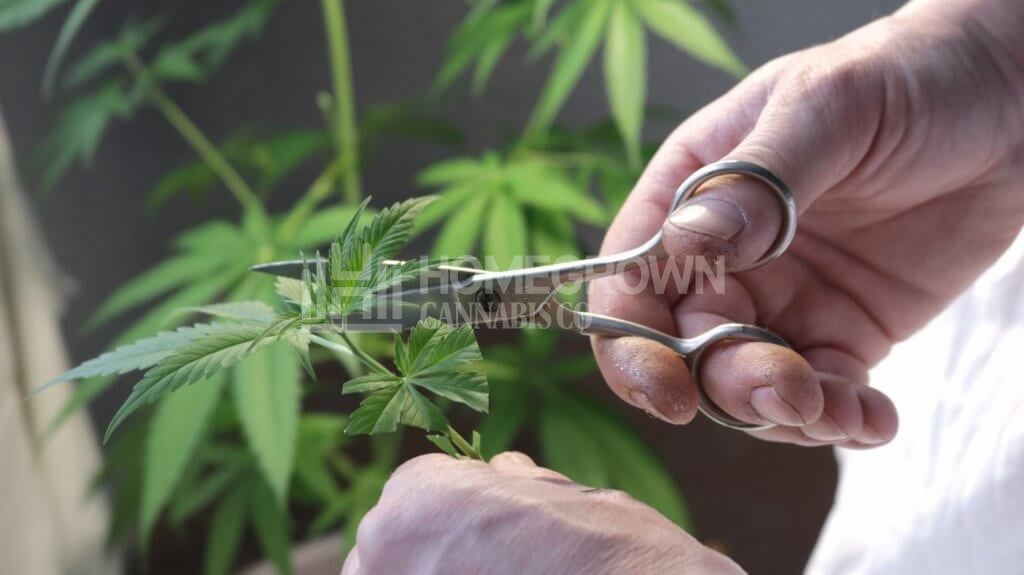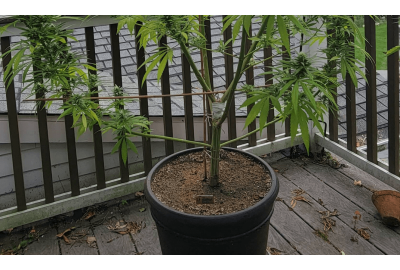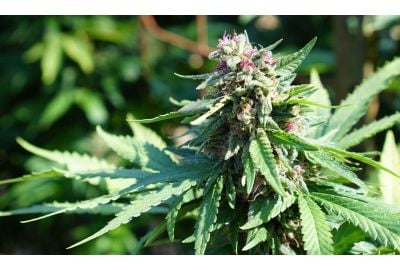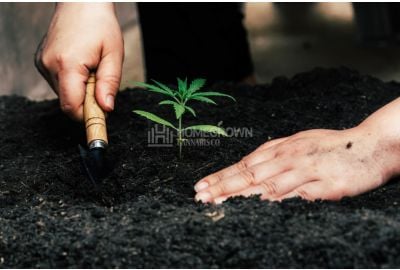Cloning Cannabis: Overview & Step By Step Guide 2023
Waiting days for your cannabis seeds to germinate can be boring and a little stressful. Overly acidic or saturated soil can impede germination and cause seeds to die and rot. When you clone marijuana, you don’t rely on the success of your seed sprouting but rather your skill in keeping your saplings alive.
As everyone knows, the growing and flowering phases are probably the coolest part of growing weed. You can visually see the limbs appear and buds develop while your excitement builds. When cloning cannabis, you skip the boring germination phase and jump right into the good stuff.

What is a cannabis clone?
The process of cloning plants isn’t a new concept. Those that can’t find seeds for a specific flora type often take a sample so they can create clones at home. People have been doing it with roses, orchids, and various other plants long before cloning cannabis.
A weed clone is essentially a genetic copy of a mother plant. Cannabis clones share similar THC, CBD, and potential as their parents. Cultivators that prefer specific cannabis strains will usually learn how to clone cannabis so they can accelerate the process.
To clone marijuana, you need branch cuttings from a mature plant. Typically, clones are about 6 inches long after separation from the mother plant. They need a neutral medium and recovery nutrients to stimulate root development.
Unlike reproduced offspring like regular seeds, there’s no “maybe” involved. You know what gender your ganja plant will be and how it looks. Breeders often use clones to make new strains and keep a heritage mother plant.
What are the advantages of cloning cannabis?
Cannabis clones are ideal for busy cultivators that want consistent results. They’re fantastic for newbies because you don’t have to wait for germination. You also have a better idea of what to expect from the mature plant. Let’s look at some of the advantages of cloning cannabis:
Time
As we’ve mentioned, cloning weed cuts out a lot of growing time. Seeds generally take between 2 and 7 days to germinate and another 3 to 6 weeks to reach adolescence. Weed clones bypass most of the wait, allowing you to start at the vegetation stage sooner than with seedlings.
Quality
Many cultivators enjoy specific potency, taste, and flavor profiles in their flowers. Cloning marijuana is a great way of ensuring high quality for every batch. Barring external factors like environment and nutrients, you’re likely to have similar nugs as before. Potency and yield sizes may drop slightly, but the overall bud quality remains the same.
Consistency
Above all, cloning cannabis is very consistent. Regardless of what strain you use, the methods are universal. Nutrients, lights, water, and the environment affect your potency and yield. If you use the same mother plant for all your clones and identical containers, you’re almost guaranteed to have indistinguishable plants.
Copies of copies
We all know what happens to a photocopy after you’ve run each new version through the scanner a few times. Eventually, the copy becomes illegible and funny-looking. Luckily, that doesn’t happen when you learn how to clone a marijuana plant from a previous one.
It’s good to be mindful of the condition of the mother plant because clones don’t have taproots. A mother clone is more likely to suffer side effects from the cutting process because of the missing taproot.
Cost
Constantly buying weed seeds can become expensive after a while. Cloning cannabis is an awesome way to save some money. You can generate infinite clones, provided you have a healthy, vegging plant.
Familiarity
Cultivating marijuana clones is a little easier than growing weed from seeds. Not only do you save time and money, but you learn about the needs of your cannabis plant. You can prevent potential issues because you’re already familiar with that specific crops’ strengths and weaknesses.
Guaranteed gender
One of the best parts of weed clones is that they’re guaranteed to be the same gender as the parent. So if you take cuttings from a male plant, the cannabis clones will be male. Similarly, you’ll have fems if you make copies of feminized seeds. As for hermies, stay away from them and remove any you find. They’re a recipe for disaster.
Breeding
Breeders might want to experiment with different strains to create hybrids. By keeping your main plant from creating seeds, you can try multiple combinations by adding different pollens. Female weed clones allow you to make copies of the main plant, mix some foreign genes, and create new seeds.

Are there any downsides to cloning weed?
Cloning cannabis may sound a bit too good to be true, so you might be wondering, “what’s the catch? Should I grow seeds or clones?" While there are many upsides to learning how to clone marijuana, there are a few downsides. Fortunately, the pros and cons of growing cannabis clones are such that you can compensate for them quite easily.
Genetics
The main “downside” is in its genetics. While your clone may have all the best aspects of the mother, it also shares the negatives. If the original plant is susceptible to pests or mildew, the new one will be as well.
Fragility
Unlike seeds, marijuana clones are quite fragile and need to be handled with care. They’re also more susceptible to infections before they’re established. Fortunately, you can increase their odds by keeping their surroundings clean and sterile.
Lower yields
The lack of a taproot in weed clones means they absorb fewer nutrients than their seedling counterparts. That makes reduced yields the biggest downside of cloning marijuana. The results are noticeable, but fortunately, you can compensate by increasing your number of clones.
To summarize the pros and cons of growing from clones, hit the play button bellow and give our PotCast a listen!
The resources you need to make a cannabis clone
Once you know how to clone weed, it doesn’t take much to get going. Nutrient packs are a good start, as you’ll need them throughout the growing process. In addition, you’ll need the same things as you would normally require, including:
A healthy mother plant: As the foundation of successfully cloning cannabis, she’ll need to be at least a month old and still in the vegetative stage. Ideally, the mother plant shouldn’t be smaller than 20 inches tall. If she’s too small, removing too many limbs may kill her.
Sharp razor blades: They work better than a knife or scissors when you’re taking cuttings for marijuana clones. You’ll need to make a smooth cut and prevent any xylem from being damaged in the process. Scissors or knives crush the xylem and create air pockets. These block water and nutrients from moving through the plant, leading to starvation and death.
You’ll need a cup filled with water: As with all plants, you need to prevent air from blocking the future stem of the plant. A good way to do this is to transfer the would-be weed clones to water immediately after removing them from the mother plant.
Have a good rooting medium: Cannabis clones need to stay wet without being waterlogged. Ensure the medium you use retains moisture well and has enough airflow. Alternatively, use a hydroponic setup.
Rooting hormone: Unless you have some seriously green thumbs, you’ll need to give your new clones nutrients that stimulate root growth. Buying high-quality food for your weed from suppliers ensures your marijuana clones get everything they need to survive and thrive.
Fluorescent lights: To keep your plants in a vegetative state, you need to maintain a light cycle of 12 hours per day. Cannabis plants that receive less than 12 hours of light per day go into the flowering phase and stop creating roots.
Humidity dome or plastic: Root development is one of the main reasons weed clones need to stay humid. Covering them with plastic bags or domes retains the moisture and keeps your clones happy.

How to clone cannabis: 7 steps to do it successfully
Don’t start chopping away at your mother plant like Edward Scissor-hands with blocks of ice. Before creating cannabis clones, separate her from the rest of the crop so you can keep your mother plant in a constant vegging state. Your equipment and environment should be clean and the razor blades sterile.
Step 1
Set up your workspace and prepare the area where you’re going to place your marijuana clone. Have the containers ready and everything nearby so you can complete the cloning process as quickly as possible. For a smooth transition, moisten your rooting medium before you begin. It’s advisable to have your rooting gel ready to apply immediately.
Step 2
A clean environment is essential for cloning cannabis. Sterilize your equipment, work area, and wash your hands before you take a cutting. The mother plant and clone are more vulnerable after snipping them, which is why it’s vital to keep unwanted bacteria away.
Step 3
Anyone who knows how to clone a weed plant will tell you it’s better to take a cutting from a vegging crop than a flowering one. While it’s possible to do either, your clone needs to revert from the budding into the vegetative stage. If you don’t mind adding an extra three weeks to the cycle, it won’t bother you too much.
Always choose a healthy limb with at least two nodes. Then, cut your chosen branch at a 45° angle, right beneath the last node. The angle increases the surface area, which helps your marijuana clone develop more roots. Once you know how to cut clones, the process becomes much easier.
Step 4
Immediately dip your cutting in the rooting gel and place it directly into the medium. Beginners should start with one clone at a time to avoid becoming overwhelmed. Your success in cloning weed is largely influenced by how fast you apply the gel and plant the branch.
Step 5
After you’ve set your new plant in the medium, trim the bottom leaves. Don’t remove the top fan leaves and growing tips because it needs those to grow. Lastly, remove the tips of the cannabis clones‘ remaining leaves to help with photosynthesis. By lowering the surface area and slowing evaporation, your clone retains water longer and develops roots faster.
Step 6
Once the trimming is over, you need to transfer your marijuana clone to a humidity dome or homemade marijuana clone box. The insulation keeps the humidity level high, which lets your clone stay hydrated. Afterward, set an 18/6 light cycle for your clone for it to remain in a vegetative state.
Step 7
Monitor your weed clone closely, and prepare the new pot before the transplant. As in the cutting stage, make sure everything is clean and sterile first. Then, gently remove your clone from the original container and plant it in the new one. Cover the roots completely and ensure there’s good aeration in the soil.

4 techniques to improve and accelerate rooting on your cannabis clone
As you can see, knowing how to clone a cannabis plant is extremely fun, educational, and quite useful. Not only can you make new plants that are practically identical to the first, but it also sheds weeks off the growing cycle. To further accelerate root growth and recovery, here are some of the best cannabis cloning methods:
Rockwool cubes
Rockwool cubes are great mediums for cloning marijuana because they’re pH neutral. They have great aeration and water retention. Cannabis likes acidic environments, so soak the cubes in ph 5.5 water for 2–3 hours. Afterward, puncture the middle of the cubes to allow for root expansion.
Soil
If you want to learn how to clone a plant in soil, use a light potting mix with perlite. You should avoid fertilized soil if you can, as your new plants could experience nutrient burn. Soak your earth and allow it to drain before inserting the cutting. Soil-based weed clones only need to be moved from their new pots once they’ve outgrown them.
Hydroponics
Rockwool can be hard to come by, and soil can be messy. Another great alternative for cloning cannabis is using water as a medium. Use unchlorinated water, and keep the pH between 5.8 and 6. You can place your cutting directly in the water after you’ve dipped it in rooting gel. To prevent your weed clones from developing infections, replace the water every few days.
Without rooting gel
Cloning cannabis without rooting gel is possible but quite difficult. You’ll need to prepare an opaque container and fill it with water. As soon as you take a cutting, place it in the water and trim the bottom leaves. Keep your clone in a windowsill outside direct sunlight, and maintain a room temperature of 74°F.
How to take good care of your weed clones
Although cloning marijuana plants is easy, it’s not without challenges. While obtaining the cutting is the most delicate part, what happens afterward determines your clones’ survival. You can show your weed clone some love through close observation and supplementing its needs where necessary.
Keep track of their progress and address any problems that you notice. Like newborn babies, cannabis clones are vulnerable and need extra care and attention. You should avoid any unnecessary stress or environmental changes at all costs in the early stages.
Once your marijuana clones have established their roots and are strong, you can adjust their feeding schedule. Measure their nutrients as recommended on the bottles, and keep the pH levels correct. When you’re satisfied with their size, you can adjust their lighting to stimulate their flowering phase.
FAQs related to cloning marijuana
There’s a good chance you still have many questions about cloning weed. Cloning is filled with possibilities and constantly unlocks doors to new ones. So, we answer some of the most frequently asked questions to help you start to do it properly.
How old should the mother plant be?
Generally, your cannabis mother plant should be at least one month old before you start cloning marijuana. She also needs to be at least 20 inches tall and have four nodes on her stem.
Can you keep cloning from clones?
It’s possible to create clones from clones, but not advisable. Genetic drift is a very slight possibility if you maintain the right conditions. The main risk you face is the mother plant dying because it can’t absorb enough nutrients.
Can you clone straight into soil?
You can plant your weed clone directly into the soil as long as you prepare the earth for it. Your cutting will also need rooting gel to develop roots.
Do clones lose potency?
Unfortunately, clones won’t have the same potency as the mother plant. Their lack of a taproot affects their potency and yields. If you cultivate clones indoors, you can compensate to a certain extent by adjusting your lights and nutrients.
Do clones yield less?
Yes. Clones don’t have a main root. While it’s not essential for their survival, marijuana clones have lower yields as a result. There are ways to compensate, but your yields won’t be as high as when you start from seed.
Do clones finish faster than seeds?
Seeds take longer to mature than clones because they have to go through the germination and seedling phases. If you plant a seed and simultaneously create a clone, your clone would be ready for harvest first. Cannabis clones skip the early stages and consequently have shorter lifespans.
What is the best medium in which to root my clones?
A very popular medium for cloning cannabis is Rockwool because of its versatility. Many cultivators claim hydroponic systems are the best way to clone roots. Soil is the least used method, as the risk of the weed clone dying is higher.
What temperature is best for my clones?
You should keep your clones at a moderate 74–78°F. It’s a comfortable temperature for marijuana and stimulates growth. Cold temperatures slow down the plants’ growth, and hot climates can cause heat exhaustion.
When will my clones start showing roots?
Depending on your cannabis cloning method, it can take anywhere from 8–12 days for roots to appear. If you took cuttings from a flowering plant, the process might take longer because it needs to change its growth pattern.

Final points about how to clone marijuana
Like growing marijuana from seeds, clones take patience and care. Whether you’re a professional breeder or still learning how to clone weed plants, don’t be too hasty. Prematurely transferring your clones from the dome to their final pots can severely damage them.
Cannabis clones grow best in environments between 74 and 78°F. Use a heating or cooling mat under your plants to moderate the temperature. Alternatively, you can install a climate control system to regulate room temperature.
Keep the relative humidity around 75–85%. You can spray your marijuana clone with water before placing it in the dome to increase humidity. Perlite has good moisture retention and works well when you place it at the bottom of the growing tray.
Regularly check up on your plants when you’re cloning cannabis to maintain the perfect environment. As sad as it sounds, you might need to spot and remove any dead clones as soon as possible. Necrotic tissues breed fungi and other pests that can destroy your weed clones very quickly.
Track your progress to see if there are any issues that you need to resolve. Joining Homegrown Diaries is a great way to monitor your progress. You can also compare your cannabis clones with others to see if you need to make changes.
If you’re stuck or unsure of something, the internet is your friend. Websites like Homegrown Forum allow users to find helpful information on growing and cloning cannabis. Look for helpful tips and tricks, or ask our friendly community a question.
To keep learning about cloning techniques, check out our guide about "air layering cannabis".
About the author: Derek LaRose
Also known as Kronic from The Cannabis Kronicles, Derek LaRose is a young ambitious cultivator and a staple educator for indoor cultivation.



